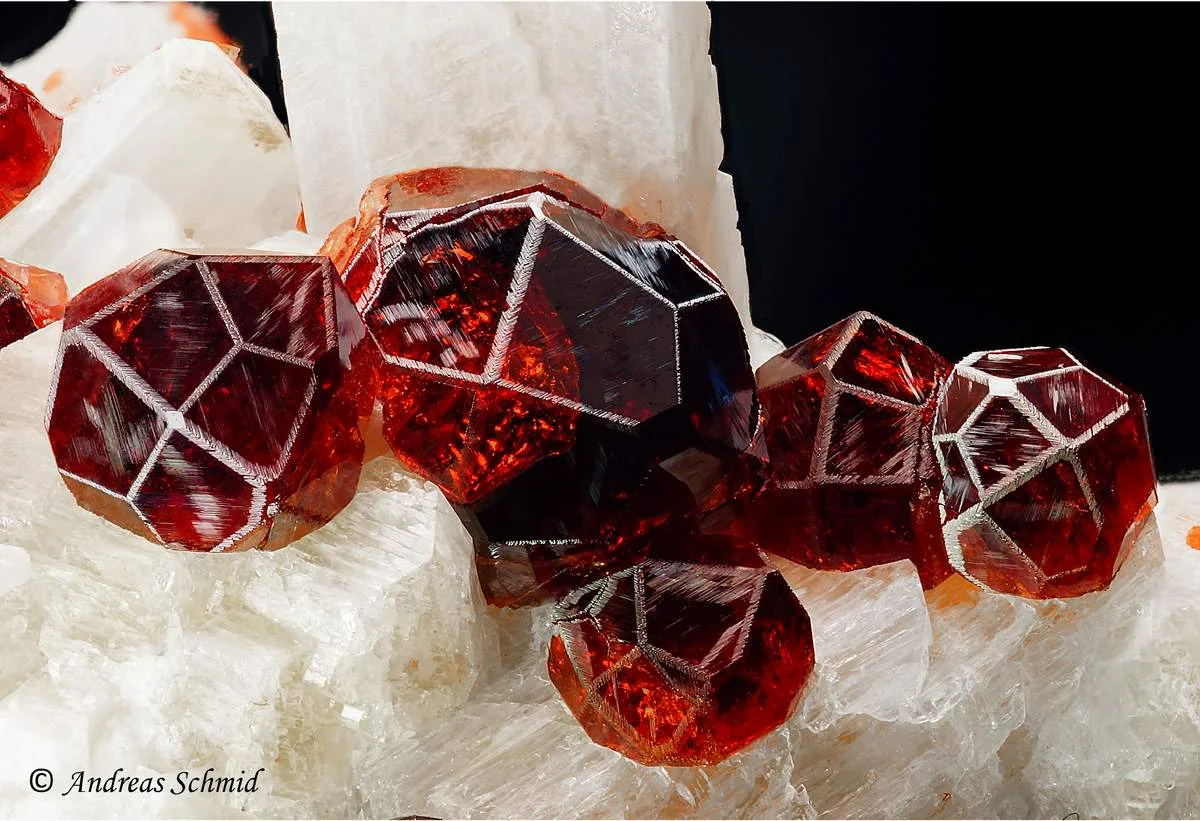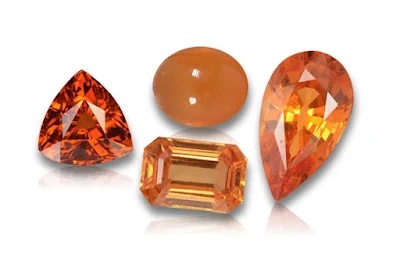Spessartine: Gemstone, Properties, Uses
Spessartine is a manganese-rich mineral belonging to the garnet group, recognized for its distinctive orange to reddish-brown coloration. This nesosilicate crystallizes in the isometric system, typically forming dodecahedral or trapezohedral crystals.
With a chemical composition of Mn₃Al₂(SiO₄)₃, spessartine forms in manganese-enriched geological environments, including granite pegmatites and metamorphic schists. The mineral exhibits a vitreous luster and demonstrates notable durability, with a Mohs hardness of 6.5–7.5.
Spessartine's most valued varieties display intense orange hues, particularly the gem-quality specimens known as "mandarin garnet." The mineral occurs in several global localities, with significant deposits in Germany's Spessart Mountains (its type locality), Nigeria, Mozambique, and the United States.
Spessartine was first discovered in the Spessart Mountains in Bavaria, Germany, which is how it got its name in the 19th century.
 |
| Spessartine Crystals. Photo: Andreas Schmid |
How does Spessartine Form
Spessartine primarily forms in metamorphosed pelitic rocks rich in manganese, where high pressure and temperature conditions drive manganese-bearing minerals to react and form garnet.
Metamorphism: When rocks containing manganese and aluminum undergo high temperatures and pressures during mountain building, they can transform into metamorphic rocks like micaschists and gneisses. In these environments, spessartine crystals can grow within the newly formed rock.
Pegmatites: These are coarse-grained igneous rocks that form during the final stages of magma crystallization. Pegmatites can be rich in rare minerals, including spessartine, which can grow into large, well-formed crystals due to the slow cooling process, leading to the formation of gem-quality spessartine crystals.
In both cases, the presence of manganese, aluminum, and silica play key roles in spessartine formation. Manganese gives the mineral its characteristic orange color, while aluminum and silica contribute to its crystal structure and hardness.
Hydrothermal alteration: Spessartine can also form through hydrothermal alteration processes, where manganese-rich fluids interact with pre-existing rocks. This can lead to the formation of spectacular veins and pockets of spessartine crystals.
 |
| Spessartine crystals. Photo: Henk Smeets/Tomeik Minerals. |
Spessartine Properties
Composition: Mn₃Al₂(SiO₄)₃. (Manganese Aluminum Silicate)
Color: Vivid orange, often with a yellow or pink tinge.
Luster: Vitreous to greasy, meaning it gleams like glass or has a slightly oily sheen.
Crystal System: Cubic, with crystals forming in isometric shapes like cubes and octahedrons.
Streak: White, the color of the powder produced when scratched.
Hardness: 7-7.5 on the Mohs scale, relatively hard and durable for a gemstone.
Cleavage: Imperfect in four directions, meaning it can break somewhat easily along specific planes.
Crystal Form: Typically found in well-formed crystals like cubes, octahedrons, and dodecahedrons. It can also occur as granular masses or inclusions in other rocks.
Transparency: Can be transparent to translucent, allowing light to pass through partially or completely.
Fracture: Uneven, meaning it breaks irregularly when stressed.
Specific Gravity: 3.98-4.18, the ratio of its density to the density of water.
Solubility: Insoluble in water, meaning it does not dissolve.
Magnetism: Non-magnetic, not attracted to magnets.
Fluorescence: Weak to moderate orange-red under longwave ultraviolet light.
Pleochroism: Weak, meaning its color appears slightly different when viewed from different angles.
Refractive Index: 1.80-1.82, a measure of how much light bends when passing through the mineral.
Inclusions: May contain inclusions of other minerals like quartz, mica, or rutile, which can add visual interest to the gemstone.
 |
| Red etched Spessartine Garnet On Albite From Skardu, Pakistan Photo: Gandhara Gems. |
Where is spessartine found
Spessartine deposits are spread across many continents, offering a variety of vibrant finds. Here's a more detailed breakdown of some notable locations:
Africa:
- Namibia: Known for its large, gem-quality crystals found in pegmatites near Luderitz.
- Tanzania: The Mang'ombe and Umba River regions boast stunning orange-yellow "Mandarin garnets," a variety of spessartine.
- Mozambique: The Alto Ligonha pegmatite field yields beautiful spessartine crystals alongside other gem minerals.
- Madagascar: The highlands contain alluvial deposits of spessartine, offering vibrant orange and reddish-orange gems.
North America:
- California: San Diego County and Ramona pegmatite district provide gem-quality spessartine in various shades.
- Maine: The Androscoggin pegmatite belt harbors spessartine, often found with tourmaline and other garnets.
- New Mexico: The Jemez Mountains and Organ Mountains offer pockets of gem-quality spessartine.
- Arizona: The White Mountains and near Prescott yield rare pink and orange spessartine crystals.
South America:
Brazil: The Minas Gerais region is famous for its gem-quality spessartine, particularly from the São José da Safira district.
 |
| Etched Spessartine Garnet from Minas Gerais, Brazil. Credit: Golden Hour Minerals |
Asia:
- Pakistan: Skardu Valley is renowned for its beautiful orange and reddish-orange spessartine crystals.
- Myanmar: The Mogok Valley is known for rare, gem-quality spessartine, sometimes in larger sizes.
- Afghanistan: The Laghman pegmatite field offers spessartine alongside other gemstones like tourmaline and kunzite.
Europe:
- Germany: The Spessart Mountains, where the mineral was first named, still holds small deposits of spessartine.
- Czech Republic: The Karlsbad region offers spessartine in pegmatites alongside other garnets and topaz.
- Austria: The Tauern Alps contain pegmatites with gem-quality spessartine crystals.
 |
| Spessartine rough and cut. Photo: indigemshow |
Spessartine Uses
Jewelry: Spessartine's warm and inviting colors make it a popular choice for jewelry designers. Whether set in rings, earrings, necklaces, or bracelets, Spessartine gemstones add a pop of color and elegance to any piece. The gem's brilliance and play of light make it a versatile choice, complementing both contemporary and vintage designs.
Collectors' Items: Rare and beautiful spessartine specimens, especially those with unusual inclusions or large formations, are prized by mineral collectors around the world.
 |
| Spessartine gemstones |
In summary, Spessartine stands out among garnets with its vibrant orange color, manganese-dominant composition, specific formation environments, and potential for high gem value. It presents a unique and captivating option for enthusiasts and collectors of colored gemstones.

%20(1).webp)






